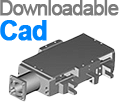Linear Motion Actuators
Precision Linear Motion Actuators: Ball & Lead Screw Options
Deltron Precision manufactures high-performance linear motion actuators, including ball screw and lead screw actuators, designed for precision, efficiency, and durability in industrial applications. Choosing the right linear motion actuator depends on factors such as load capacity, speed, and accuracy requirements. These mechanical devices translate rotary motion into linear motion and are essential components in industries including manufacturing, packaging, food and beverage, and aerospace. They are also found in everyday devices such as medical diagnostic equipment, 3D printers, machine tools, and robots.
Linear motion actuators can be operated by mechanical lead screws, ball screws, hydraulics, pneumatics, and piezoelectric means. Learn more about the four types of linear actuators and how they work. The most common types of linear motion actuators are mechanically driven by either lead screws or ball screws.
For many applications, either a lead screw or a ball screw could be used, but each has its own distinct advantages depending on the specific application requirements.
Lead Screw Linear Motion Actuators

Lead screw linear motion actuators, in their simplest form, are composed of a screw and a nut. As the screw is turned, the nut travels down the length of the screw, transporting a payload. A spring pushes the 2-piece nut apart to create preload to reduce backlash (axial play). While there are many variations in both screw and nut designs, lead screw assemblies’ inherent simplicity makes them more cost-effective for lighter-duty applications where speed, precision, rigidity and overall accuracy are needed. Despite a larger frictional energy loss because of the contact between the screw and the nut, lead screw linear motion actuators are generally quiet, smooth, clean, self-lubricating, corrosion resistant.
Ball Screw Linear Motion Actuators

Ball screw linear motion actuators also utilize a screw and a nut, but the thread is filled with balls to reduce friction. As the balls move along the path of the helical screw, they are returned from the end to their starting point under the transport mechanism. Ball screw linear motion actuators offer minimal friction, high efficiency, are smoother and more accurate. They are typically used in applications which require higher loads, load speeds and longer life.
Deltron Linear Motion Actuators
Some of the considerations when determining whether a lead screw table or a ball screw table is ideal for a specific application include the required size, footprint, operating speed, load capacity, positioning accuracy, duty cycle and environmental conditions.
For over 45 years, Deltron Precision has been providing companies with the perfect linear motion solutions for their specific needs. Our DL series linear actuators are available in both lead screw and ball screw versions and offer the benefit of space-saving designs, fast and simple assembly, long life, and competitive pricing. Our Posi Drive® lead screw actuators are compact, economical, require no alignment of components, and install with standard fasteners.
Frequently Asked Questions About Linear Motion Actuators
What is a linear motion actuator?
A linear motion actuator converts rotary motion into precise linear movement. It is commonly used in automation, robotics, and industrial machinery.
What is the difference between a lead screw and a ball screw actuator?
Lead screw actuators are more cost-effective and suitable for lighter loads, while ball screw actuators offer higher efficiency, load capacity, and precision.
How do I choose the right linear motion actuator for my application?
Factors to consider include load capacity, speed, precision, duty cycle, and environmental conditions. Contact us for expert guidance.
Other industry terms for linear motion actuators which Deltron Precision manufactures include: lead screw driven stages, lead screw stages, ball screw stages, lead screw tables, ball screw tables, linear actuators, ball screw actuators, ball screw driven stages, XY tables and more generally as linear bearings, linear motion slides, or simply motion slides.
For cost efficiency and quick turnaround times, Del-Tron Precision delivers. Visit www.Deltron.com or call 800-245-5013.
Click here for our Product Guide Catalog in Inches, here for our Product Guide Catalog in Metric and here for our DL Series Catalog.

